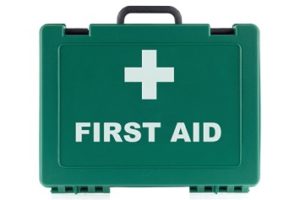Federal OSHA does not require employers to record injuries that only require first aid on OSHA injury and illness forms (OSHA Form 300 and 301 Incident Reports). At most workplaces, injuries or illnesses requiring only first aid are commonplace.

Lebazele / E+ / Getty Images
However, it is easy to get confused about when to record an incident and what is really a recordable event. This article will explain which types of cases federal OSHA considers other recordable or simply limited to first aid and not recordable.
Column J: Other Recordable Cases
A case is OSHA recordable if it involved treatment beyond first aid or a diagnosis of significant injury or illness.
If the employee did not have days away from work (Column H), job transfer, or restriction (Column I), the case is recorded in Column J: Other Recordable Cases. You must also record the appropriate category under Column M: Injury and Illness Types.
Examples of these cases include:
- Medical treatment that does not fall under first aid, such as:
- Prescription medication. The use of nonprescription medication at prescription strength as recommended by a physician or a licensed healthcare professional (PLHCP) is considered prescription medication.
- Immunizations (except tetanus) such as hepatitis B or rabies vaccines.
- Wound-closing devices such as surgical glue, sutures, staples, etc.
- Any device with rigid stays or other systems designed to immobilize parts of the body.
- Therapeutic massages such as physical therapy or chiropractic treatment.
- Removal of foreign materials embedded in the eye.
- Significant diagnosed injury or illness—any serious or significant work-related disorder that is diagnosed by a PLHCP or identified by a positive medical test. These include cases of cancer, chronic irreversible disease, a fractured or cracked bone or tooth, or a punctured eardrum.
- Needlestick injuries and cuts from sharp objects that are contaminated with another person’s blood or other potentially infectious materials. Potentially infectious materials include human bodily fluids, tissues and organs, and materials infected with HIV or the hepatitis B virus.
- An OSHA standard requires medical removal of an employee for medical surveillance.
- Loss of consciousness from a work-related injury or illness is reportable. Loss of consciousness due solely to personal health conditions (diabetes, epilepsy, narcolepsy, etc.) is not recordable.
Not Recordable
If a case is limited to first-aid treatment and there are no days away from work, job transfer, or job restriction, do not include the case on your OSHA 300 Log. The case is not OSHA recordable, even if the first-aid treatment is administered at a health clinic, emergency room, hospital, or other medical treatment facility.
“First-aid treatment” is defined as:
- Visits to a PLHCP solely for observation or counseling.
- Diagnostic procedures, such as X rays and blood tests, including the administration of prescription medications solely for diagnostic purposes (such as eye drops to dilate pupils).
- Using nonprescription medications at nonprescription strength (per box instructions).
- Cleaning and flushing, or soaking wounds on the surface of the skin.
- Using wound coverings, such as such as bandages, Band Aids, gauze pads, butterfly bandages, Steri-strips, and other similar coverings. (Note: Wound-closing devices are medical treatment.)
- Using any nonrigid means of support, such as elastic bandages, wraps, nonrigid back belts, etc.
- Using temporary immobilization devices while transporting a victim, such as splints, slings, neck collars, and back boards.
- Drilling of fingernail or toenail to relieve pressure, or draining fluid from a blister.
- Removing splinters or foreign material from areas other than the eyes by irrigation, tweezers, a cotton swab, or other means.
- Removing foreign bodies from the eye using only irrigation or a cotton swab.
- Using eye patches or finger guards.
- Nontherapeutic massages (spa treatments).
- Using hot or cold therapy.
- Drinking fluids for relief of heat disorder.
- Administering tetanus immunizations.
Making the Case
- A worker cuts her hand and goes to the emergency room. A nurse cleans and covers the wound with a Band-Aid and sends her back to work. Is this recordable?
- This is not a recordable case; only first aid was administered.
- An employee suffers cumulative trauma injuries due to poor ergonomics of his workstation, requiring extensive physical therapy. If he “sucks it up” and is able to continue his normal work duties, is this recordable?
- Yes, this is a recordable case. Physical therapy is medical treatment beyond first aid, so the case is recordable in Column J (other recordable cases).
- An employee steps on a rusty nail and gets a tetanus shot at the walk-in clinic. Is this an OSHA recordable case?
- No this is not a recordable case. A tetanus shot is defined as first aid.
- While at work, a worker goes into diabetic shock and loses consciousness. She stays home for 3 days. Is this recordable?
- This is not a recordable case. Her loss of consciousness was 100 percent related to a personal medical condition, and not work-related.

I agree with the case decisions above, as they meet the regulation’s requirements. For the first case, it does not matter that a nurse provided first aid; the same decision would apply if a physician provided it. For more complex cases, the decision tool at OSHArecordable.com can be useful.